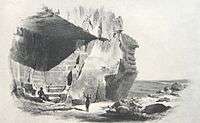Tura, Egypt
Tura (Egyptian Arabic: طرة Tora IPA: [ˈtˤoɾˤɑ]) was the primary quarry for limestone in ancient Egypt.[1] The site, which was known by the ancient Egyptians as Troyu or Royu, is located about halfway between modern-day Cairo and Helwan.[2] Its ancient Egyptian name was misinterpreted by the Ancient Greece geographer Strabo who thought it meant it was inhabited by Trojans, thus the Hellenistic city was named Troia.[3] The site is located by the modern town of Tora in the Cairo Governorate.[4]

Ancient mining town
The limestone from Tura was the finest and whitest of all the Egyptian quarries, so it was used for facing stones for the richest tombs,[5] as well as for the floors and ceilings of mastabas which were otherwise made of mudbrick.[6] It was used during the Old Kingdom and was the source of the limestone used for the "Rhomboidal Pyramid" or Bent Pyramid of Sneferu,[7] the Great Pyramid of Khufu,[8] the sarcophagi of many old kingdom nobles,[9] the pyramids of the Middle Kingdom,[10] and certain temples of the New Kingdom built by at least Ahmose I, who may have used Tura limestone to begin the temple of Ptah at Memphis and the Southern Harem of Amun at Thebes.[11]
The Tura limestone was deep underground and instead of open-pit mining, the miners tunneled deep underground to cut large stones out, leaving some limestone behind to support the caverns left behind.[3] The caves were adapted by British forces during World War II to store ammunition, aircraft bombs, and other explosives.[12] These tunnels were surveyed in 1941, and in quarry 35, workmen found many loose quires from books by Origen and Didymus the Blind, two Alexandrian Church Fathers. The workers who found them stole them, and although some were seized by the authorities, most are still missing, and turn up on the antiquities market from time to time. It is believed that some of the original books could have been up to 480 pages.[13]
References
- Grimal, Nicholas. A History of Ancient Egypt. p. 27. Librairie Arthéme Fayard, 1988
- Grimal, Nicholas. A History of Ancient Egypt. p. 111. Librairie Arthéme Fayard, 1988
- Quarries of Masara and Tura Archived 2007-09-30 at the Wayback Machine Accessed July 28, 2006
- Talbert, Richard. Barrington Atlas of the Greek and Roman World. p. 74. (ISBN 0-691-03169-X)
- Tura Archived 2011-07-24 at the Wayback Machine Accessed 2009-06-16
- Helwan Accessed July 28
- Grimal, Nicholas. A History of Ancient Egypt. p. 109. Librairie Arthéme Fayard, 1988
- Great Pyramid Accessed July 28, 2006
- Grimal, Nicholas. A History of Ancient Egypt. p. 129. Librairie Arthéme Fayard, 1988
- Grimal, Nicholas. A History of Ancient Egypt. p. 177. Librairie Arthéme Fayard, 1988
- Grimal, Nicholas. A History of Ancient Egypt. p. 200. Librairie Arthéme Fayard, 1988
- Playfair, Vol. I, page 65.
- The Tury Discovery of Manuscripts Accessed July 28, 2006
Bibliography
- Playfair, Major-General I.S.O.; Molony, Brigadier C.J.C.; with Flynn, Captain F.C. (R.N.) & Gleave, Group Captain T.P. (2009) [1st. pub. HMSO:1954]. Butler, Sir James (ed.). The Mediterranean and Middle East, Volume I: The Early Successes Against Italy, to May 1941. History of the Second World War, United Kingdom Military Series. Uckfield, UK: Naval & Military Press. ISBN 1-84574-065-3.